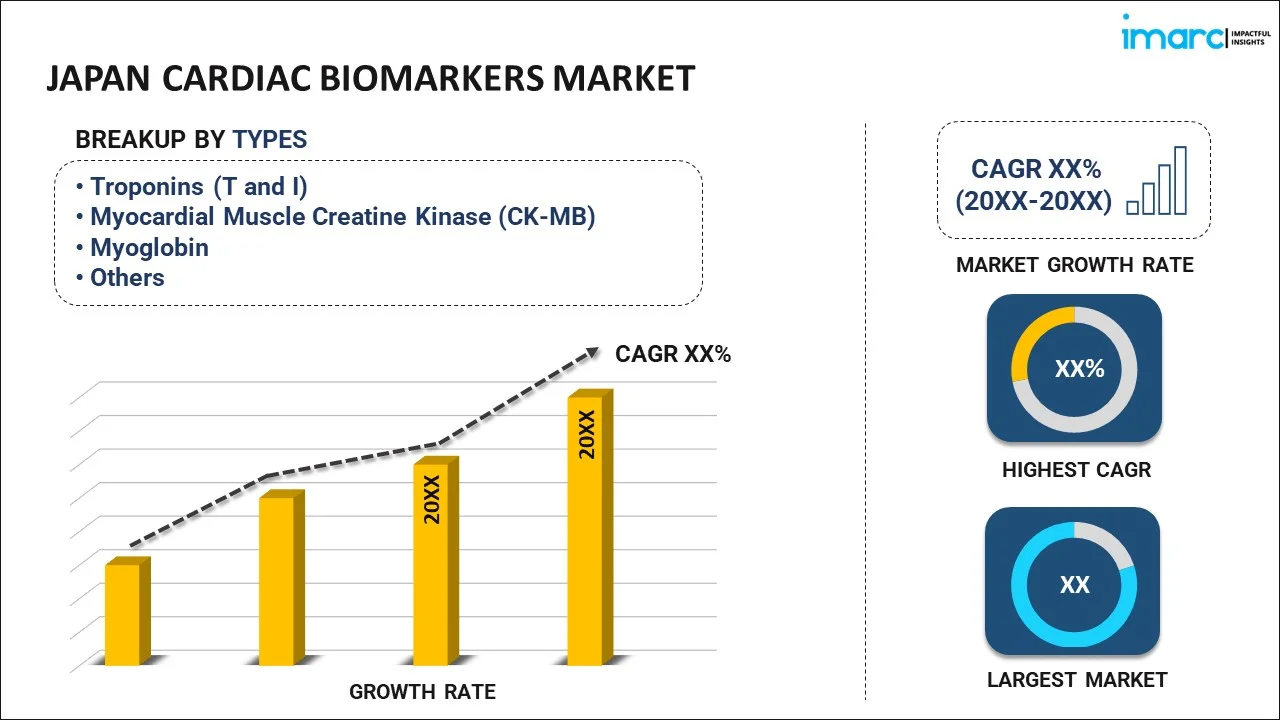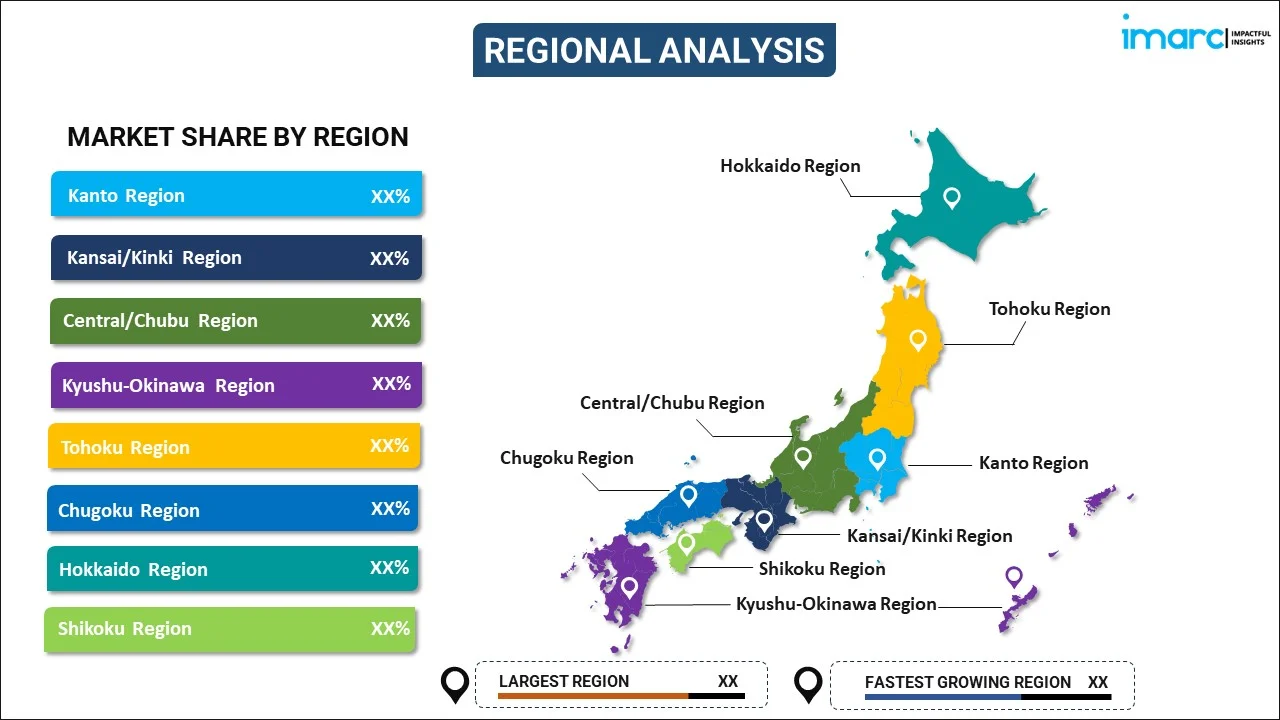
Japan Cardiac Biomarkers Market Report by Type (Troponins (T and I), Myocardial Muscle Creatine Kinase (CK-MB), Myoglobin, Brain Natriuretic Peptide (BNPs) or NT-proBNP, Ischemia Modified Albumin (IMA), and Others), Location of Testing (Laboratory Testing, Point of Care Testing), Application (Myocardial Infarction, Congestive Heart Failure, Acute Coronary Syndrome, Atherosclerosis, and Others), and Region 2025-2033
Market Overview:
Japan cardiac biomarkers market size reached USD 680.1 Million in 2024. Looking forward, IMARC Group expects the market to reach USD 1,302.7 Million by 2033, exhibiting a growth rate (CAGR) of 7.5% during 2025-2033. The increasing prevalence of cardiovascular diseases such as heart attacks, strokes, and heart failure, that require cardiac biomarkers for early detection, risk assessment, and monitoring of patients, is driving the market.
|
Report Attribute
|
Key Statistics
|
|---|---|
|
Base Year
|
2024
|
|
Forecast Years
|
2025-2033
|
|
Historical Years
|
2019-2024
|
| Market Size in 2024 | USD 680.1 Million |
| Market Forecast in 2033 | USD 1,302.7 Million |
| Market Growth Rate 2025-2033 | 7.5% |
Cardiac biomarkers are proteins or molecules released into the bloodstream in response to heart-related conditions. They play a crucial role in diagnosing and monitoring various heart disorders. Common cardiac biomarkers include troponins, creatine kinase-MB (CK-MB), and B-type natriuretic peptide (BNP). Troponins are highly specific indicators of heart muscle damage and are essential in diagnosing heart attacks. CK-MB is another enzyme that rises in response to heart muscle injury. BNP, on the other hand, helps assess heart failure and its severity. Measuring cardiac biomarkers through blood tests allows healthcare professionals to detect and evaluate heart problems, determine the extent of damage, and formulate appropriate treatment plans. These biomarkers provide valuable insights into the overall health of the heart and help guide medical interventions to improve patient outcomes. Regular monitoring of cardiac biomarkers is essential in managing heart conditions and preventing complications.
Japan Cardiac Biomarkers Market Trends:
The cardiac biomarkers market in Japan is poised for substantial growth, driven by several key factors. Firstly, the escalating prevalence of cardiovascular diseases, including coronary artery disease and heart failure, has significantly increased the demand for cardiac biomarker testing. Additionally, the aging regional population is a major driver, as older individuals are at higher risk of cardiac-related issues, creating a sustained need for cardiac biomarker diagnostics. Moreover, advancements in medical technology and the increasing adoption of high-sensitivity cardiac biomarker assays have enhanced the accuracy and efficiency of cardiac disease detection. This has not only improved patient outcomes but also encouraged healthcare providers to incorporate these tests into their routine clinical practices. Furthermore, the growing awareness among both healthcare professionals and patients regarding the importance of early cardiac disease detection and prevention has led to increased testing rates. The emphasis on preventive healthcare and proactive monitoring of cardiac health has bolstered the cardiac biomarkers market. Lastly, supportive government initiatives and funding for cardiovascular research and diagnostic tools have fueled market expansion. Overall, these drivers converge to create a favorable landscape for the cardiac biomarkers market's sustained growth in the foreseeable future.
Japan Cardiac Biomarkers Market Segmentation:
IMARC Group provides an analysis of the key trends in each segment of the market, along with forecasts at the country level for 2025-2033. Our report has categorized the market based on type, location of testing, and application.
Type Insights:

- Troponins (T and I)
- Myocardial Muscle Creatine Kinase (CK-MB)
- Myoglobin
- Brain Natriuretic Peptide (BNPs) or NT-proBNP
- Ischemia Modified Albumin (IMA)
- Others
The report has provided a detailed breakup and analysis of the market based on the type. This includes troponins (T and I), myocardial muscle creatine kinase (CK-MB), myoglobin, brain natriuretic peptide (BNPS) or NT-proBNP, ischemia modified albumin (IMA), and others.
Location of Testing Insights:
- Laboratory Testing
- Point of Care Testing
A detailed breakup and analysis of the market based on the location of testing have also been provided in the report. This includes laboratory testing and point of care testing.
Application Insights:
- Myocardial Infarction
- Congestive Heart Failure
- Acute Coronary Syndrome
- Atherosclerosis
- Others
The report has provided a detailed breakup and analysis of the market based on the application. This includes myocardial infarction, congestive heart failure, acute coronary syndrome, atherosclerosis, and others.
Regional Insights:

- Kanto Region
- Kansai/Kinki Region
- Central/ Chubu Region
- Kyushu-Okinawa Region
- Tohoku Region
- Chugoku Region
- Hokkaido Region
- Shikoku Region
The report has also provided a comprehensive analysis of all the major regional markets, which include Kanto Region, Kansai/Kinki Region, Central/ Chubu Region, Kyushu-Okinawa Region, Tohoku Region, Chugoku Region, Hokkaido Region, and Shikoku Region.
Competitive Landscape:
The market research report has also provided a comprehensive analysis of the competitive landscape. Competitive analysis such as market structure, key player positioning, top winning strategies, competitive dashboard, and company evaluation quadrant has been covered in the report. Also, detailed profiles of all major companies have been provided.
Japan Cardiac Biomarkers Market Report Coverage:
| Report Features | Details |
|---|---|
| Base Year of the Analysis | 2024 |
| Historical Period | 2019-2024 |
| Forecast Period | 2025-2033 |
| Units | Million USD |
| Scope of the Report | Exploration of Historical Trends and Market Outlook, Industry Catalysts and Challenges, Segment-Wise Historical and Future Market Assessment:
|
| Types Covered | Troponins (T and I), Myocardial Muscle Creatine Kinase (CK-MB), Myoglobin, Brain Natriuretic Peptide (BNPs) or NT-proBNP, Ischemia Modified Albumin (IMA), Others |
| Location of Testings Covered | Laboratory Testing, Point of Care Testing |
| Applications Covered | Myocardial Infarction, Congestive Heart Failure, Acute Coronary Syndrome, Atherosclerosis, Others |
| Regions Covered | Kanto Region, Kansai/Kinki Region, Central/ Chubu Region, Kyushu-Okinawa Region, Tohoku Region, Chugoku Region, Hokkaido Region, Shikoku Region |
| Customization Scope | 10% Free Customization |
| Post-Sale Analyst Support | 10-12 Weeks |
| Delivery Format | PDF and Excel through Email (We can also provide the editable version of the report in PPT/Word format on special request) |
Key Questions Answered in This Report:
- How has the Japan cardiac biomarkers market performed so far and how will it perform in the coming years?
- What has been the impact of COVID-19 on the Japan cardiac biomarkers market?
- What is the breakup of the Japan cardiac biomarkers market on the basis of type?
- What is the breakup of the Japan cardiac biomarkers market on the basis of location of testing?
- What is the breakup of the Japan cardiac biomarkers market on the basis of application?
- What are the various stages in the value chain of the Japan cardiac biomarkers market?
- What are the key driving factors and challenges in the Japan cardiac biomarkers?
- What is the structure of the Japan cardiac biomarkers market and who are the key players?
- What is the degree of competition in the Japan cardiac biomarkers market?
Key Benefits for Stakeholders:
- IMARC’s industry report offers a comprehensive quantitative analysis of various market segments, historical and current market trends, market forecasts, and dynamics of the Japan cardiac biomarkers market from 2019-2033.
- The research report provides the latest information on the market drivers, challenges, and opportunities in the Japan cardiac biomarkers market.
- Porter's five forces analysis assist stakeholders in assessing the impact of new entrants, competitive rivalry, supplier power, buyer power, and the threat of substitution. It helps stakeholders to analyze the level of competition within the Japan cardiac biomarkers industry and its attractiveness.
- Competitive landscape allows stakeholders to understand their competitive environment and provides an insight into the current positions of key players in the market.
Need more help?
- Speak to our experienced analysts for insights on the current market scenarios.
- Include additional segments and countries to customize the report as per your requirement.
- Gain an unparalleled competitive advantage in your domain by understanding how to utilize the report and positively impacting your operations and revenue.
- For further assistance, please connect with our analysts.
 Inquire Before Buying
Inquire Before Buying
 Speak to an Analyst
Speak to an Analyst
 Request Brochure
Request Brochure
 Request Customization
Request Customization




.webp)




.webp)












